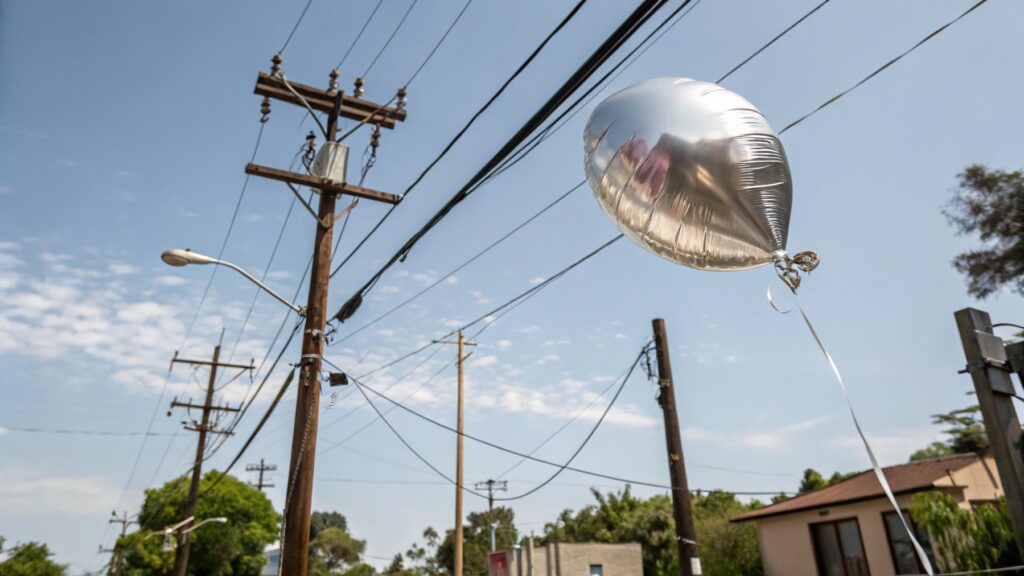Worried about balloon safety? We all want fun parties, but are latex and Mylar balloons really safe for everyone? Let's look at the risks.
Latex and Mylar balloons have different safety concerns. Latex balloons are a choking risk1, especially for young children. Mylar balloons can be a fire risk near power lines. Both types can cause issues if not used correctly.

When planning a party, we often think about decorations. Balloons are popular. But it's important to know about safety. My team and I have seen many different types of balloons over the years. We know how they are made and how they can be used safely. We always put safety first in our work.
Are you scared about kids choking on balloons? This is a real worry for parents and party planners. It's important to know the facts.
Latex balloons are a major choking hazard for young children. Uninflated or broken pieces can easily block a child's airway. This is why supervision is key2.

We have heard many sad stories about children and balloons. It is not something to take lightly. Here are the main risks with latex balloons:
Latex balloons, when not blown up or when they break, become small pieces. Little kids like to put things in their mouths. These small pieces can easily be swallowed. They can get stuck in the throat or windpipe. This can stop breathing.
If a balloon piece is swallowed, it is hard to remove. The latex is flexible and can form a tight seal. This makes it different from other small toys. It is harder to get out once it is stuck.
Here is a table showing the risks:
| Condition | Risk | Why it Happens |
|---|---|---|
| Uninflated balloon | Choking | Small size, easy to swallow by young children |
| Broken balloon | Choking | Pieces are small and irregular shaped |
| Chewing on balloon | Inhalation | Pieces can be inhaled into airways |
It is very important to keep uninflated balloons and broken balloon pieces away from young children. Always watch children when they are around balloons.
Do you worry about Mylar balloons causing fires? This is a concern, especially when they float outside. It's good to understand this risk.
Mylar balloons, also called foil balloons, are made of a metallic material. This material can conduct electricity. If a Mylar balloon touches power lines, it can cause a short circuit. This can lead to fires or power outages.

We always tell people to be careful with Mylar balloons outdoors. I have heard reports of problems caused by balloons touching power lines. It is a serious issue. Here is more about the fire risks:
The metallic coating on Mylar balloons is the problem. It is a good conductor of electricity. When the balloon floats up and hits a power line, the electricity travels through the balloon. This completes an electrical circuit.
Completing an electrical circuit with a power line causes a short circuit. This creates a sudden flow of electricity. It can cause sparks and heat. These sparks can ignite nearby materials. This can start a fire. Also, it can cause the power to go out for many people.
Here is how the risk happens:
| Factor | Role in Risk |
|---|---|
| Metallic coating | Conducts electricity |
| Helium filling | Makes balloon float high |
| Wind | Moves balloon towards power lines |
It is very important to tie Mylar balloons securely. Do not let them go outside. If a Mylar balloon gets loose, it can float for a long time and travel far. Always deflate Mylar balloons before throwing them away. This stops them from floating if they get out of the trash.
Are you concerned about allergies from balloons? This is something people with latex allergies3 need to think about.
Popped latex balloons can cause allergic reactions in people sensitive to latex. The powder and latex particles released when a balloon pops can trigger symptoms like hives, itching, or breathing problems in allergic individuals.

We know that latex allergies are serious for some people. As a company that makes latex balloons, we are aware of this. We try to make our products as safe as possible, but the risk exists for those with allergies. Here is more about balloon allergies:
Latex balloons are made from natural rubber latex. This latex contains proteins that can cause allergic reactions in some people. When a balloon is handled or pops, these proteins can become airborne or stay on the surface.
An allergic reaction to latex can be mild or severe. Mild symptoms include skin rash, itching, and hives where the latex touched the skin. More severe reactions can include sneezing, runny nose, itchy eyes, and breathing problems like wheezing. In rare cases, it can cause anaphylaxis, which is a life-threatening emergency.
Here are ways people are exposed:
| Exposure Method | Risk Level | Notes |
|---|---|---|
| Touching balloon | Low to Medium | Contact dermatitis, hives |
| Inhaling particles | Medium to High | Respiratory symptoms, asthma triggers |
| Popped balloon | Medium to High | Release of particles into the air |
If you know someone has a latex allergy, it is best to avoid latex balloons. Mylar balloons are a good alternative because they are made from plastic, not latex. Always tell guests if you are using latex balloons.
Do you wonder if some balloons are better for older kids? Yes, age matters when it comes to balloon safety4.
Age recommendations are important for balloon safety. Latex balloons are not recommended for children under 8 years old due to the choking hazard. Mylar balloons can be used by younger children with supervision, but care is needed with the ribbon to prevent strangulation.

In our experience, supervising children with balloons is always a good idea, no matter their age. But there are specific risks for very young children with latex balloons. Here are some age-specific points:
These children should not have access to any balloons. They are at the highest risk of choking on small parts. Uninflated or broken balloons are extremely dangerous for this age group.
These children can use Mylar balloons with adult supervision. They should not be given uninflated latex balloons to blow up. Adult supervision is needed when they are around inflated latex balloons to quickly clean up any broken pieces.
Children over 8 can typically handle latex balloons with less direct supervision for inflation. However, adult supervision is still recommended, especially when the balloons are being popped or deflated, to ensure proper disposal of pieces.
Here are age recommendations summarized:
| Balloon Type | Recommended Age | Safety Notes |
|---|---|---|
| Latex Balloons | 8+ with supervision | High choking risk for younger children |
| Mylar Balloons | All ages with supervision | Ribbon strangulation risk, less choking risk |
It is crucial to always supervise young children around all types of balloons. Teach older children how to handle and dispose of balloons safely. Choose helium over hydrogen for inflation for any balloon type to avoid explosion risks. Helium is much safer. Also, remember that Mylar balloons are not good for the environment as they do not break down like latex balloons do.
Latex balloons pose choking and allergy risks, while Mylar balloons can be a fire hazard near power lines. Always supervise children5 and choose helium over hydrogen for safety.
Learning about choking risks can help prevent accidents and ensure children's safety during celebrations. ↩
Supervision is essential to prevent choking incidents with balloons. Learn more about effective supervision strategies for kids. ↩
Explore the symptoms and precautions for those with latex allergies to stay safe around balloons. ↩
Discover essential safety practices for using balloons, especially around children, to prevent accidents and allergic reactions. ↩
Supervision is key to preventing accidents with balloons. Discover why it's crucial to keep an eye on children during playtime with balloons. ↩

Passionate developer focused on frontend development and user experience design. Love exploring new technologies and sharing knowledge through articles.
🔗Connect with Me